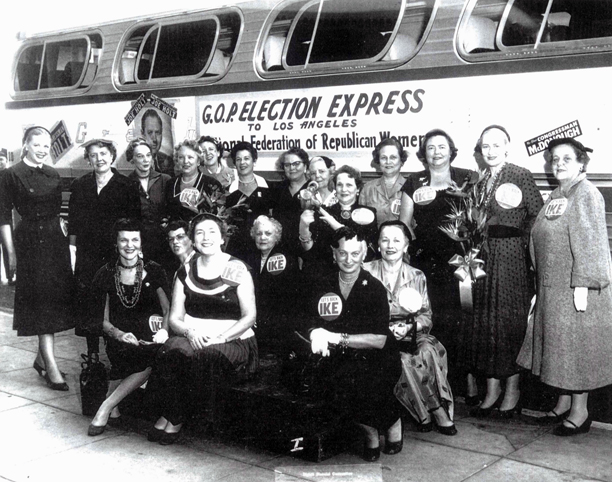
The "2016 Destination: White House" campaign tour featuring Rosie wasn't the NFRW's first bus tour. In September 1954, members embarked on the "G.O.P. Election Express," an 11-day bus trek from Washington, D.C., to Los Angeles. Here, participants are shown preparing for the trip.
The story of Republican women's clubs begins many years before women even had the right to vote. Inspired by the Republican Platform of 1872, which said: "The Republican Party is mindful of its obligation to the loyal women of America for their noble devotion to the cause of Freedom ...," Republican women’s clubs were off and running. In fact, the oldest such club on record was founded in Salt Lake City in the late 1800s.
Hundreds of independent Republican women’s clubs grew up around the nation in the years to come. For example, there were 140 clubs in Indiana alone by the late 1930s.
It was in 1938 that Marion Martin, assistant chairman of the Republican National Committee, called a meeting at the Palmer House in Chicago to organize these clubs into a national organization.
States in which Republican women’s clubs were organized on a “statewide” basis sent delegates and alternates to that meeting with a request to affiliate with such an organization. To be considered "statewide" at that time, a state or local club had to have members in 60 percent of the counties of that state. (Later this rule was changed to cover either 50 percent of the counties or 75 percent of the state's congressional districts.)
The delegates adopted rules governing the establishment of a National Federation of Republican Women’s Clubs, with the following purposes:
"to foster and encourage loyalty to the Republican Party and the ideals for which it stands - to promote education along political lines - to encourage closer cooperation between independent groups and the regular party organization, which are working for the same objectives, namely sound government - to promote an interchange of ideas and experiences of various clubs to the end that the policies which have proven particularly effective in one state may be adopted in another - and to encourage a national attitude and national approach to the problems facing the Republican Party."
Eleven states became the charter states of NFRW - California, Colorado, Connecticut, the District of Columbia, Indiana, Maryland, Michigan, Missouri, Montana, New Jersey and Pennsylvania.
At the age of 31, Joyce Arneill of Denver, Colo., was elected the first president of the Federation, and the organization began to grow.
At the time of NFRW’s founding, three states – Maryland, Virginia, and Alabama – had not even ratified the 19th amendment to the U.S. Constitution granting suffrage to women. The campaign of 1936 had reelected Franklin D. Roosevelt over Alf Landon with only two states – Maine and Vermont – going Republican. There were only six Republican governors, 89 Republicans in the U.S. House of Representatives, and 16 in the Senate.
And yet the National Federation of Republican Women – born in a climate of defeat – grew in size and strength, providing a vehicle for women concerned with the direction of our government.
In 1940, the NFRW reported that, “Since the founding of the Federation, there has been a steady and consistent progress.” Thirty-four states, as well as the District of Columbia, were represented in the Federation through statewide federations and/or individual clubs.
In its earliest days, the Federation was a lobbying group. In 1940, NFRW enlisted the support of its members to urge their representatives in Washington to hold free and open hearings and a full investigation on the amendments to the Wagner Labor Relations Act. They wrote their representatives during National Debt Week to impress them with the fact that constituents were concerned about the national debt. And on June 10, 1940, NFRW President Joyce Arneill sent a letter to all club presidents urging their help in keeping Congress in session until the immediate crisis of the “foreign situation” was past.
By September 1, 1943, 23 statewide federations held membership in the national organization, along with 98 individual clubs from 16 states. In January 1953, the organization's name was changed to the National Federation of Republican Women.
Today, the NFRW – once an auxiliary of the Republican National Committee – is financially and organizationally independent. It is one of the largest grassroots political organizations in the country with thousands of active members in local clubs across the nation.
The goals of those women who met in Chicago in 1938 continue to be the goals of the NFRW – to encourage women’s participation in the governing of our nation, to elect Republicans to office at all levels, and to promote public awareness of the issues that shape America.
Biennial national conventions have been held in cities across the nation, with U.S. presidents and vice presidents, first ladies, cabinet members, legislators, party leaders, political experts, and celebrities attending. Presidential candidates never miss these meetings. They know that many of those attending will be delegates to the Republican National Convention or will be instrumental in the delegate selection process. They know that these women are the GOP’s grassroots activists.
Programs such as NFRW’s campaign management schools, women candidate seminars, and polling schools have trained literally thousands of Republican women and men to help elect GOP candidates, and communities throughout the nation have benefited from the volunteer services of NFRW’s Caring for America and literacy programs.
Millions of American women, ages 19 to 90, have helped shape our nation through wartime and peace, through depression and prosperity, through good times and bad – all through the National Federation of Republican Women.